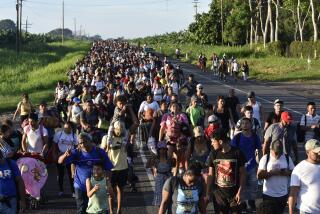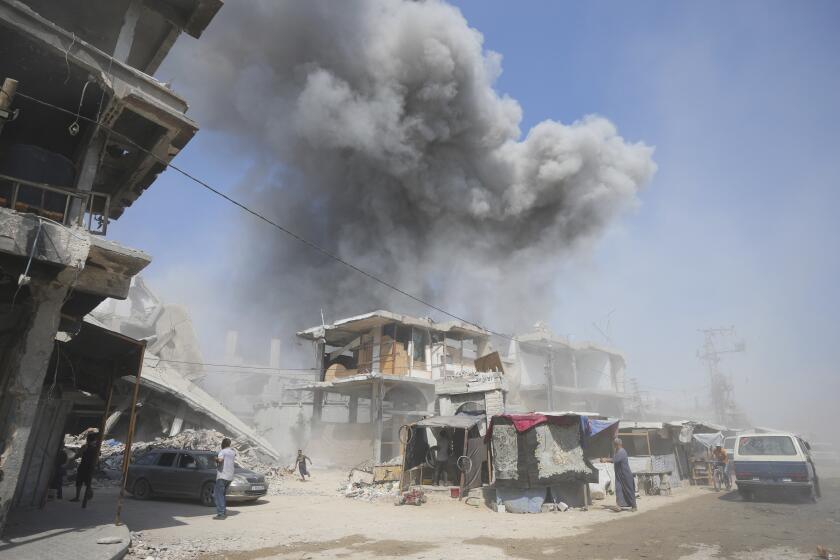Garner Believes Hussein Killed Up to 1 Million
The former head of the U.S.-led effort to rebuild Iraq predicted Wednesday that investigators would find the corpses of as many as 1 million Iraqis who were executed during Saddam Hussein’s rule.
Reflecting the Bush administration’s increasing emphasis on human rights violations by Hussein -- as more time passes without the discovery of weapons of mass destruction -- retired Army Lt. Gen. Jay Garner offered the highest such estimate to date by a present or former senior official of the U.S.-led coalition.
“I think before it’s all over that we will come close to uncovering 1 million bodies killed from probably in the mid-’80s all the way up to the time of the war,” Garner said.
His estimate of the number of citizens slain by the Hussein government in “killing fields” scattered mostly in Shiite Muslim regions of Iraq is plausible, said Ann Clwyd, Britain’s envoy to Iraq for human rights.
In an interview reflecting on his four months as head of the Office of Reconstruction and Humanitarian Assistance, Garner brushed aside criticism of his efforts. He asserted that the United States would succeed in building a new, democratic and peaceful Iraq.
“I think there’s unrealistic expectations on the part of those who are criticizing,” Garner said.
Those on the reconstruction team -- since redubbed the Coalition Provisional Authority -- knew that, he said.
“I said: ‘When you get there, it’s going to be the most chaotic thing you ever experienced in your life. And you’ll look up and say, how in the hell can we get this done?’ ” Garner recalled. “And I just said, ‘Hang in there, because it’ll all start coming together.’ And it is now.”
The task, Garner said, will take a year or two. He added that his replacement, L. Paul Bremer III, “has got at least the third-hardest job in the world -- behind [President] Bush and [British Prime Minister Tony] Blair -- and it may be harder.”
Garner, 65, who spent more than three decades in the Army, said his mission in Iraq was “the most challenging job I ever had.” He added, “It was also the most rewarding job I’ve ever had.”
Garner rejected criticism that he arrived in Baghdad too late to win over Iraqi hearts and minds and that he spent much of his time holed up in the palace that serves as the reconstruction effort’s headquarters.
“In the first 30 days, I had 71 meetings with Iraqis” outside the palace, he said, from clerics to garbage collectors.
Garner blamed the reconstruction effort’s slow start on massive looting that gutted virtually every major government ministry his agency planned to use as key elements in rebuilding. He also blamed the faulty telecommunications system, much of which was destroyed by U.S. forces during the war.
The looting could not have been prevented, he said, because American combat forces were too busy trying to capture Baghdad while most of the thievery took place. Combat operations and law enforcement, he said, are mutually exclusive.
Among the top priorities facing U.S. troops is the capture of Hussein, Garner said. He said lingering uncertainty about the fate of the deposed Iraqi president will continue to complicate reconstruction.
“It’s got to be a huge priority,” Garner said. “Every day they’re farther away from him.... The specter of him diminishes just a little bit every day that you don’t find him, every day that we’re there. But it will take a hell of a long time to eliminate the whole specter if we don’t find him.
“I think 90% of the Iraqi people are happy as hell” that the United States invaded and occupied their country, he said. “But they’re not saying anything because they have the experience of: ‘He [Hussein] was there with us for 30 years, and nobody has showed me his body yet. And if he comes back, he’s going to get even with everybody.’ So they’re just sitting there doing nothing. They’re fence-sitters just watching.”
Garner spoke most passionately about the mass graves, especially those near Hillah.
“You go stand out in those killing fields and look at them exhume the remains and put them in those plastic bags, some of them aren’t any bigger than this,” he said, holding his arms barely a yard apart. “They’re just kids -- a significant number of them.”
Other estimates of the number slain during Hussein’s rule range from 500,000 to 800,000, according to Clwyd, a member of the British Parliament.
“Anything’s possible in this country where so many people disappeared or were executed,” said Clwyd, who recently returned from a visit to Iraq.
Records of the dead were carefully kept by Hussein’s government. Yet much of the data remains unreviewed.
As recently as three weeks ago at Abu Ghraib prison near Baghdad, records of the dead littered the floor. The papers suggested that some victims were fed into “plastic shredders,” machines designed to shred plastic that were found at the site. Prison records referred to death by “mincing,” she said.
Said Garner: “I went to just one killing field outside of Hillah
“I asked the governor there, ‘How many people got killed?’ And he said in Hillah alone, we’re missing over 100,000 people ... and if you go farther down south ... what they did down here was they brought the army in, and they began shelling the city in artillery barrages, and the people would rush out of the city, and then they’d just cordon them off, round them up ... and start killing them.”
More to Read
Sign up for Essential California
The most important California stories and recommendations in your inbox every morning.
You may occasionally receive promotional content from the Los Angeles Times.






